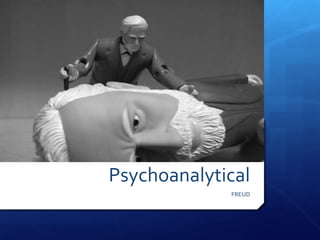04 - Psychoanalytical
•Download as PPTX, PDF•
5 likes•1,732 views
Freud's psychoanalytic theory proposes that personality is composed of three parts: the id, ego, and superego. The id operates on the pleasure principle, seeking instant gratification. The ego develops to satisfy the id's desires in a realistic way based on the reality principle. The superego incorporates societal values and causes guilt when standards are not met. Behavior results from unconscious drives and the constant interaction between these three parts to reduce psychological tension.
Report
Share
Report
Share

Recommended
Recommended
More Related Content
What's hot
What's hot (20)
Chapter 2 Research Methods in Social Psychology.pptx

Chapter 2 Research Methods in Social Psychology.pptx
Psychological Games People Play - Transactional Analysis

Psychological Games People Play - Transactional Analysis
Viewers also liked
Viewers also liked (18)
Similar to 04 - Psychoanalytical
Similar to 04 - Psychoanalytical (20)
Athene Noctua Undergraduate Philosophy Journal Issue .docx

Athene Noctua Undergraduate Philosophy Journal Issue .docx
psychoanalytictheorybysigmundfreud-210604045800.pdf

psychoanalytictheorybysigmundfreud-210604045800.pdf
Pychodynamic personality theory its contributions and limitations

Pychodynamic personality theory its contributions and limitations
More from Dickson College
More from Dickson College (20)
Recently uploaded
Recently uploaded (20)
Exploring_the_Narrative_Style_of_Amitav_Ghoshs_Gun_Island.pptx

Exploring_the_Narrative_Style_of_Amitav_Ghoshs_Gun_Island.pptx
Unit 3 Emotional Intelligence and Spiritual Intelligence.pdf

Unit 3 Emotional Intelligence and Spiritual Intelligence.pdf
Kodo Millet PPT made by Ghanshyam bairwa college of Agriculture kumher bhara...

Kodo Millet PPT made by Ghanshyam bairwa college of Agriculture kumher bhara...
Micro-Scholarship, What it is, How can it help me.pdf

Micro-Scholarship, What it is, How can it help me.pdf
Food safety_Challenges food safety laboratories_.pdf

Food safety_Challenges food safety laboratories_.pdf
UGC NET Paper 1 Mathematical Reasoning & Aptitude.pdf

UGC NET Paper 1 Mathematical Reasoning & Aptitude.pdf
Python Notes for mca i year students osmania university.docx

Python Notes for mca i year students osmania university.docx
This PowerPoint helps students to consider the concept of infinity.

This PowerPoint helps students to consider the concept of infinity.
On National Teacher Day, meet the 2024-25 Kenan Fellows

On National Teacher Day, meet the 2024-25 Kenan Fellows
HMCS Max Bernays Pre-Deployment Brief (May 2024).pptx

HMCS Max Bernays Pre-Deployment Brief (May 2024).pptx
Basic Civil Engineering first year Notes- Chapter 4 Building.pptx

Basic Civil Engineering first year Notes- Chapter 4 Building.pptx
Salient Features of India constitution especially power and functions

Salient Features of India constitution especially power and functions
General Principles of Intellectual Property: Concepts of Intellectual Proper...

General Principles of Intellectual Property: Concepts of Intellectual Proper...
04 - Psychoanalytical
- 1. Psychoanalytical FREUD
- 2. Psychoanalytic Approach To Personality Psychoanalytical Approach based on Freud’s work. The idea that behaviour can be influenced by an unconscious part of the mind.
- 3. Freudian Theory of Personality Three Parts of the Mind Aspects of mind which houses our thoughts and cognitive activities 3 parts: the conscious, the preconscious, the unconscious
- 4. The Conscious Contains thoughts of which you are currently aware Constantly changing as new thoughts enter the mind and others pass out of awareness
- 5. The Preconscious Stores all the thoughts you could easily bring into consciousness if you wanted to. E.g. what you ate for breakfast, who your kindergarten teacher was, etc.
- 6. The Unconscious According to Freud, vast majority of our thoughts are in the unconscious No immediate access to Cannot bring into consciousness except under certain extreme situations. Responsible for much of our everyday behaviour.
- 7. Three parts of the Personality In Freud’s view, the human personality could be divided into three parts: Id, ego and superego According to Freud, these parts are often not at peace with one another
- 8. Id The one and only part to the human personality AT BIRTH. Actions based on pleasure principle – the id is only concerned with satisfying personal desires, regardless of limitations or consequence. These reflexive actions are still present as adults, but held in check by other parts of the personality. Id uses wish fulfillment to satisfy its needs: if a baby is hungry with no food nearby, the id imagines the food and temporarily satisfies the need. Id impulses are unconscious, therefore we are unaware of all the impulses we might wish to act upon.
- 9. Ego 0-2yrs + interaction with environment = ego Ego’s actions based on the reality principle – that is, the primary job of the ego is to satisfy the id impulse, but in a realistic way. Keeps unacceptable and dangerous id impulses in the unconscious
- 10. Superego About five years = superego Represents society’s and parents’ values and standards Places more restrictions on what one can and cannot do. Primary weapon – guilt! According to Freud, some children fail to fully develop the superego due to poor child-rearing practices. Can also become too powerful (“supermoral”), with impossible standards of perfection.
- 11. The Interaction of the Three Parts
- 12. Putting it altogether… Freud’s Topographical Model
- 13. Instincts and Tension Reduction Freud maintained that human behaviour is motivated by strong internal forces – drives/instincts Two major categories of instincts: 1) life/sexual instincts - Eros 2) death/aggressive instincts - Thanatos The two types combine to motivate behaviours. Freud attributed most human behaviour to the life/sexual instinct. Note: sexual includes anything resulting in pleasure. Death instinct: the desire we all have to die and return to the earth. Mostly unconscious. Expression: self destruction, aggression against others.
- 14. Instinct Activation Increased psychological tension is created. Comparable to feelings of excitation, nervousness and arousal. Tension remains until the particular need is satisfied. Undesirable state = goal of most human behaviour to reduce the tension and return to a state of no tension.